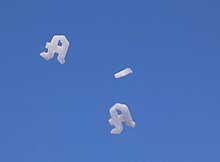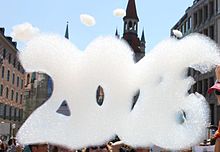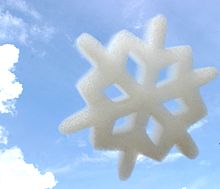Flogo

Flogos (made up of "flying" or "flying" and " logos ") are dimensionally stable, individually designed motifs made of foam that can be used indoors or outdoors and soar into the air. They can be used to label the sky, which is why they are often associated with the term “skyvertising” or aerial advertising . Essentially, helium- filled soap bubble foam is shaped using a template.
Generation and Ascension
A relatively flat box is folded up to 3 times the height of a cube, which, depending on the type, has a side length of around 75 or 100 cm. In this machine, a shallow, round basin is filled with aqueous soap fluid. A helium- air mixture, which flows through 3 to 4 multi-pore nozzles at the bottom, causes a column to foam up, which rises up in the textile, cylindrical shaft. Water runs downwards from the lamellae of the foam bubbles in a countercurrent, the foam becomes “drier”, i.e. drip-free, lighter and more dimensionally stable. At the top, the foam may penetrate through a grille and the cut-out opening of a template , which thus forms the logo in two dimensions. After the formation of a suitable (protruding) layer thickness, a thin pipe wipes just over the stencil and thus separates a flat piece of foam, the flogo.
If the foam is lighter than the surrounding air, the piece formed from it rises. A new flogo is fabricated every 30 seconds or so. To protect the foam, this is done behind an all-round windbreak. So that the object can be seen in flight for as long as possible, it should only rise slowly and only have a low wind speed and, if possible, no air turbulence. In order to show a non-rotationally symmetrical logo upright, it is made heavier (in terms of images :) at the bottom by foaming with more air and lighter at the top with more helium. This is achieved through separate regulators for each type of gas and different nozzles. If some water still runs down inside the foam during flight, the set flight tendency is increased.
The pieces of foam need a funnel-shaped free space upwards to rise and drift. The direction is determined by the wind or, indoors, the flow of the ventilation system. Flogos rise more slowly than latex balloons. The resulting smaller Reynolds number and the non-circular, flat shape promotes a stable flight position with a more laminar flow around, while more spherical balloons stagger more due to more turbulence. The foam logos live for up to a few minutes and can rise up to 1,500 meters and cover distances of up to 10 kilometers, while the bubbles break down into droplets of detergent . As mere foam, they represent practically no danger - free of solid bodies - for aircraft and jet engines and therefore do not require approval.
Buoyancy, lamellar thickness and dynamics
The difference in density between helium and air corresponds to the maximum achievable buoyancy per volume of around 1 gram per liter. Foam that rises will therefore have less lamellar mass per volume of foam. 1 g / L is just 1/1000 of water. If you consider bubbles in the middle of the foam to be cube-shaped, the gas content of ONE bubble must exactly support the lamellae of THREE sides of the cube. So that this works out with the degree of filling = 1/1000, a cube of 1 cubic meter size can be covered with lamellae exactly 1/3000 m = 1/3 mm thick when viewed enlarged. Bubbles with a realistically small diameter of 3 mm could have a wall thickness corresponding to 1 micrometer. In fact, this thickness is well below this, because 1. the soap solution concentrated in the lamella is significantly denser than water and 2. the interior of the bubble also contains significantly less than 100% of the lifting gas helium, but also air.
More precise models would take into account that the gas content of the bubbles is under slightly higher pressure than the surrounding atmosphere, since the surface tension of the soap solution exerts additional pressure via the tensile force of the lamellae. Bubbles in wet foam will be fairly saturated with water vapor, but air outside the foam may be “drier”. Foam is subject to a certain influence of thermal radiation from all around and evaporation cold of its water content. Dynamically, it must be taken into account that helium and some water vapor diffuses outwards through the lamellae (and very little air in the opposite direction). Bubbles that burst on the surface due to mechanical stress (due to drafts of air) and drying out release their entire gas content into the open, but only atomize part of their aliquot mass. If the ambient air is oversaturated with water vapor, water could condense on the foam as dew , and small raindrops and light snowflakes could also be caught.
Motifs
Flogos are designed individually and can represent letters , company logos, lettering, numbers or other symbols . The size of almost 100 cm also allows the shape of more complex motifs.
Areas of application
- Marketing measures , e.g. B. Promotion campaigns, guerrilla marketing campaigns, sponsoring
- Events , e.g. B. Company celebrations, private parties, city festivals, music festivals
- Fixed installations, e.g. B. Sponsorship in stadiums, theater or show stages, amusement parks
- Video and film recordings


